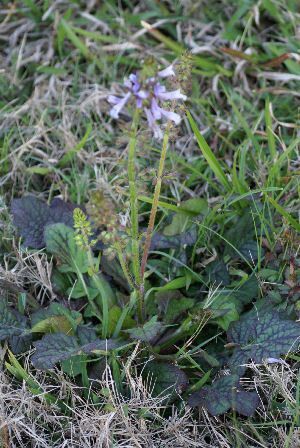Lyreleaf Sage

Salvia lyrata
Family: Lamiaceae (Mint Family)
Lyreleaf Sage (Salvia lyrata) is a versatile, native perennial plant found throughout Texas, particularly in the southeastern region. This low-growing mint family member is well-known for its attractive blue-violet flowers, semi-evergreen foliage, and resilience in various habitats. It is an excellent choice for pollinator gardens, naturalized landscapes, and erosion control.
- Scientific Name: Salvia lyrata
- Common Names: Lyreleaf Sage, Cancerweed
- Family: Lamiaceae (Mint Family)
- Growth Habit: Herbaceous perennial
- Height: 12-24 inches
- Leaves: Deeply lobed, lyre-shaped basal leaves, often tinged with purple
- Flowers: Pale blue to violet, tubular, appearing on spikes from spring to early summer
- Bloom Time: March – June in Southeast Texas
- Wildlife Benefits: Attracts bees, butterflies, and hummingbirds
Habitat & Range in Southeast Texas
Lyreleaf Sage thrives in a variety of environments, from open woodlands to roadsides, meadows, and disturbed areas. In Southeast Texas, it is commonly found in:
- Pineywoods: Prefers semi-shaded areas with well-drained soils
- Coastal Prairies: Grows in open fields and along trails
- Urban and Suburban Areas: Frequently used in native gardens and naturalized landscapes
This adaptable plant tolerates different soil types, including sandy and clay soils, and withstands periods of drought once established.
Ecological Importance
- Pollinator Plant: The nectar-rich flowers provide an essential food source for native bees, butterflies, and hummingbirds.
- Ground Cover & Erosion Control: Forms dense rosettes that help prevent soil erosion in both natural and landscaped areas.
- Wildlife Habitat: Its foliage and flowers support a variety of insects, which in turn benefit local bird populations.
Landscaping & Gardening Uses
Due to its adaptability and aesthetic appeal, Salvia lyrata is a valuable addition to native gardens in Southeast Texas.
Planting & Care
- Sunlight: Full sun to partial shade
- Soil: Prefers well-drained soil but tolerates clay and sandy conditions
- Water Needs: Low to moderate; drought-tolerant once established
- Maintenance: Minimal care required; can self-seed and spread naturally
- Companion Plants: Ideal alongside Gulf Coast Penstemon (Penstemon tenuis), Texas Bluebonnet (Lupinus texensis), and Indian Blanket (Gaillardia pulchella)
Fun Facts
- The common name Cancerweed originates from traditional medicinal uses of the plant, though it is not widely used today.
- It is one of the few native salvias that can tolerate damp conditions, making it unique among Texas salvias.
- The leaves turn deep purple in colder months, adding seasonal interest to gardens.
Conservation & Native Plant Advocacy
Promoting the use of Salvia lyrata in Southeast Texas landscapes helps support native ecosystems and reduce the reliance on non-native ornamental plants. As urban expansion continues, incorporating native species like Lyreleaf Sage is vital for preserving local pollinator populations and maintaining ecological balance.
Where to Find It
-
Interested in adding Lyreleaf Sage to your garden? Check if this is in stock or add to cart to purchase directly from our Natives Nursery.


